All plants always bring human life freshness and peace; each has its own beauty to attract attention. That is the reason why plants are always interesting to have! They are not only green, but you can also have plants with various other colors, one of which is purple.
Purple plants will make your home feel more elegant and dramatic. If you also love this color, here are the 7 Best Beautiful Purple Indoor Plants to liven up your living space.
They have unique purple foliage and a warm texture to melt any heart, so they will bring your indoor space extra texture. When growing them, you can mix these purple shades with pink, blue, and even white-colored plants to give your home a more classic and befitting appearance.
Love them, let’s start growing some, even if purple isn’t your favorite color, or simply you want your home to spruce up, whatever the case might be, they promise to keep you satisfied.
#1 Persian Shield
The Persian Shield is a stunning purple ornamental plant; it grows as a delicate evergreen perennial and produces purple and colorful-looking leaves.
Thanks to its broad, glossy leaves covered in silver shimmer, growing beautifully, you can grow the plant as an annual or ornamental in the home garden in groups.
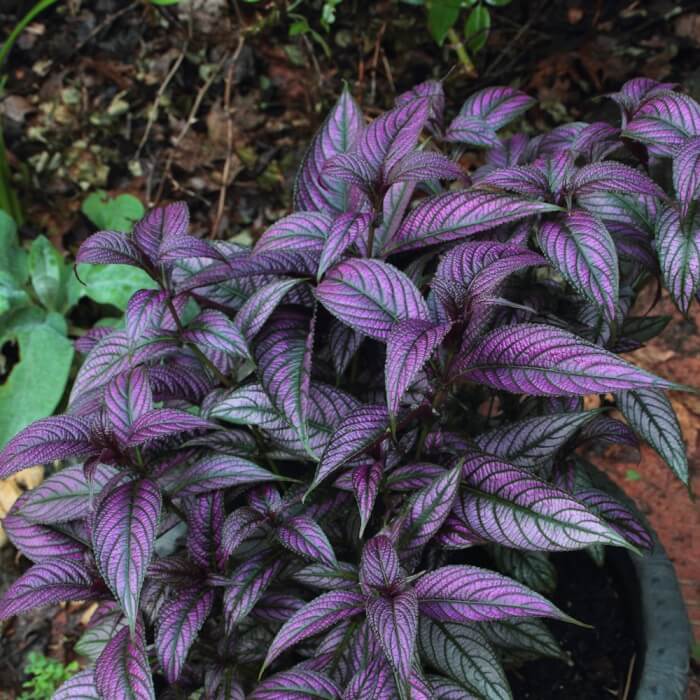
Here are some tips to help you successfully care for your Persian Shield:
- Give it bright and indirect sunlight, you can place your plant near a window with filtered or dappled sunlight. Make sure to avoid direct sunlight, as it can scorch the leaves.
- Keep the indoor temperature between 65°F to 75°F (18°C to 24°C) for optimal growth. Avoid exposing the plant to cold drafts or sudden temperature fluctuations.
- This houseplant prefers high humidity levels. You can increase humidity by using a humidity tray, a room humidifier, or misting the plant regularly.
- Keep the soil consistently moist but not soggy. Water the plant when the top inch (2.5 cm) of soil feels dry to the touch. Be cautious not to overwater, as excessive moisture can lead to root rot.
#2 Oxalis Triangularis
Oxalis Triangularis is the most beautiful purple ornamental plant in recent years, which many gardeners love growing in the garden and the landscape.
It offers heart-shaped and thin flowers that resemble trumpet flowers. To grow this plant, give it moderate sun and avoid excessive watering.
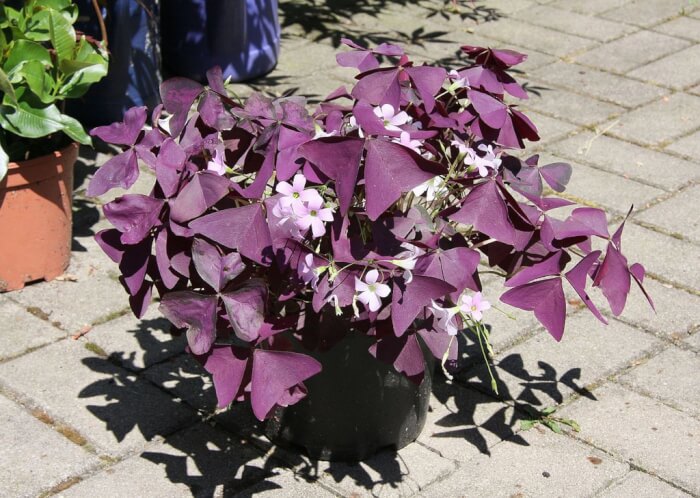
In addition, there are some tips to grow this plant lushly in your home.
- Use a well-draining potting mix to prevent waterlogged roots, as it is susceptible to root rot.
- Keep the indoor temperature between 60°F to 75°F (15°C to 24°C).
- This plant prefers moderate to high humidity levels. You can increase humidity by using a humidity tray, a room humidifier, or misting the plant regularly.
- Pinch back leggy growth and faded flowers regularly to encourage bushier growth and continuous flowering.
#3 Echeveria
Echeveria is a beautiful succulent and has lots of types that show off purple color with a soft and shabby visual. The succulent type grows well both indoors and outdoors.
You can grow it in a small pot for decorating the room table and enjoy its thick leaves with a conical shape. Also, give the plant lots of light but avoid watering too much for happy growth.
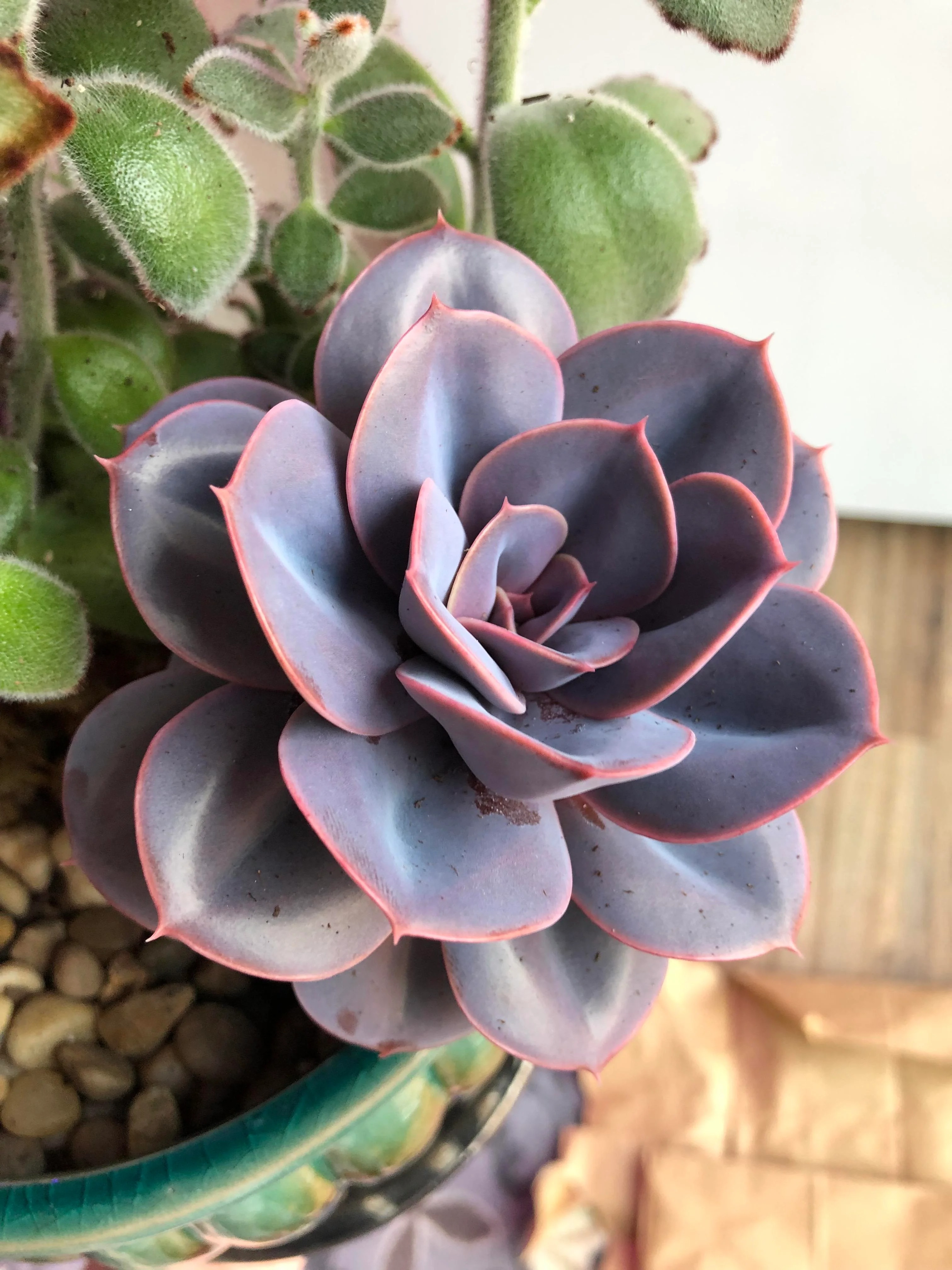
Place your plant in a south or west-facing window where it can receive at least 6 hours of sunlight per day. It prefers a warm environment.
Keep the indoor temperature between 65°F to 75°F (18°C to 24°C) during the day and slightly cooler at night. Protect your Echeveria from cold drafts, as they are sensitive to low temperatures.
Avoid over-fertilizing, as succulents are sensitive to excess nutrients, which can lead to leggy growth or root problems. Prune Echeveria as needed to maintain its shape and remove any dead or damaged leaves. Deadhead spent flowers to encourage continuous blooming.
#4 Coleus
Coleus is an easy-care tropical plant that can be started from seeds or cuttings. It bears stacked small leaves, especially when grown from seeds, they will grow at the bottom easily and in clusters.
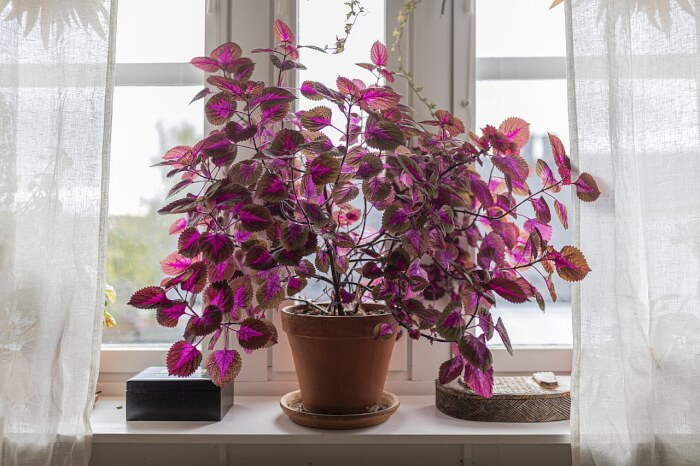
Feed your plant with a balanced, water-soluble fertilizer diluted to half strength every 4-6 weeks during the growing season. Be careful not to overfertilize, as this can lead to excessive growth with less vibrant leaf color.
Pinch back the growing tips of your Coleus regularly to encourage branching and a bushier appearance. You can also remove any leggy or yellowing stems. Use insecticidal soap or neem oil if aphids, mealybugs, or spider mites infestation.
#5 Gynura Aurantiaca
Gynura Aurantiaca showcases pretty hairy leaf shapes and stunning yellow flowers. It grows well on a windowsill where it gets easy light regulation.
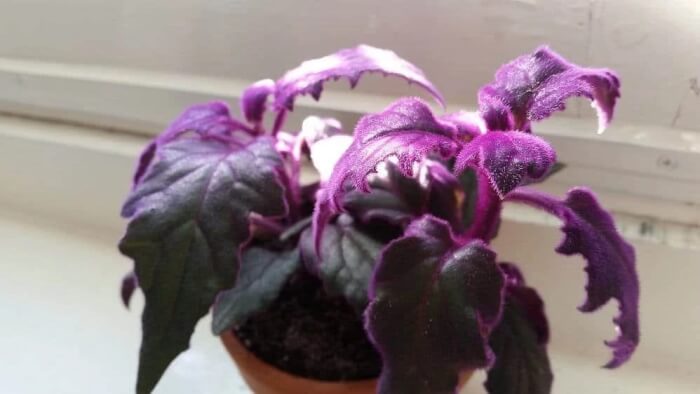
Keep the soil consistently moist but not waterlogged. Ensure that the pot has proper drainage to prevent water from accumulating in the bottom of the pot, which can lead to root rot.
Use a well-draining potting mix with good aeration. Repot your plant every 1-2 years or when it outgrows its pot.
Feed your Gynura aurantiaca with a balanced, water-soluble fertilizer diluted to half strength every 4-6 weeks during the growing season (spring and summer). Reduce or stop fertilization during the dormant period in the fall and winter.
Prune it regularly to promote bushier growth and maintain shape. As the plant grows, it may become top-heavy. Use stakes or supports to help keep it upright and maintain its shape.
#6 Corral Bells
Corral Bells are great purple options that have leaf colors of bronze, purple, and more. Its blooming time is from late spring to early summer with stunning flowers.
Also, the beauty of the plant is shown by the unique leaf shape that is almost like a heart shape with grooves and leaf veins that are clearly visible.
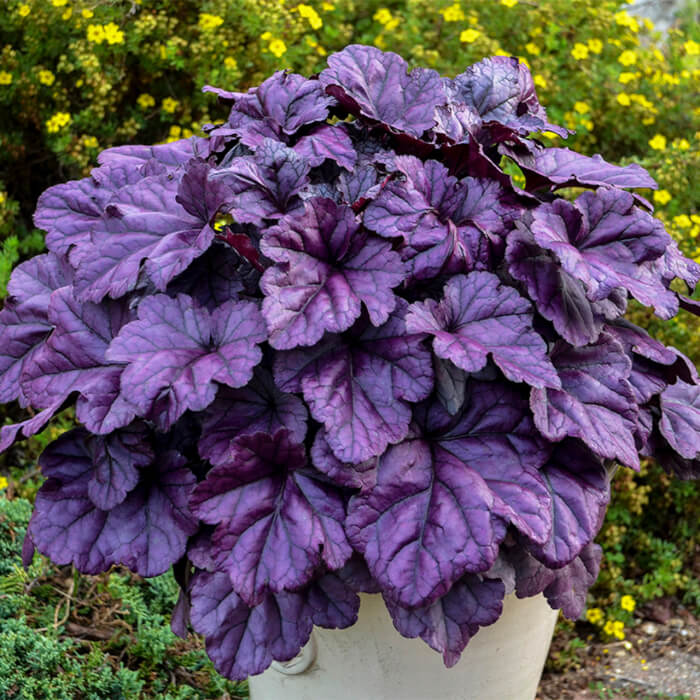
Here are some tips for successfully growing your Coral Bells indoors:
- Provide bright, indirect sunlight. Avoid direct sun exposure, especially in hot, sunny climates, as it can scorch the leaves.
- This plant typically thrives in average indoor humidity. Keep the soil consistently moist but not waterlogged. Water when the top of the soil feels dry to the touch. Water at the base of the plant to avoid getting the leaves wet, which can lead to fungal issues.
- Use well-draining potting soil with good aeration. Repot your plants when they become root-bound or outgrow their pots.
- Check your plants regularly for common indoor plant pests such as aphids, spider mites, or mealybugs. Treat any infestations promptly with insecticidal soap or neem oil. Watch for signs of fungal diseases, and ensure good air circulation around the plant to prevent moisture buildup on the leaves.
#7 Tradescantia Zebrina
Tradescantia Zebrina is widely known for its purple leaf color, the silver, purple, and green leaves mixed into one, making it a beautiful visual. You can grow the vine plant in hanging baskets for a tropical look in your living space.
To help it grow healthy and vibrant indoors, give it bright, indirect sunlight by placing your plant near a window with filtered or dappled sunlight. It can tolerate some direct morning sunlight but avoid strong afternoon sun, which can scorch the leaves.
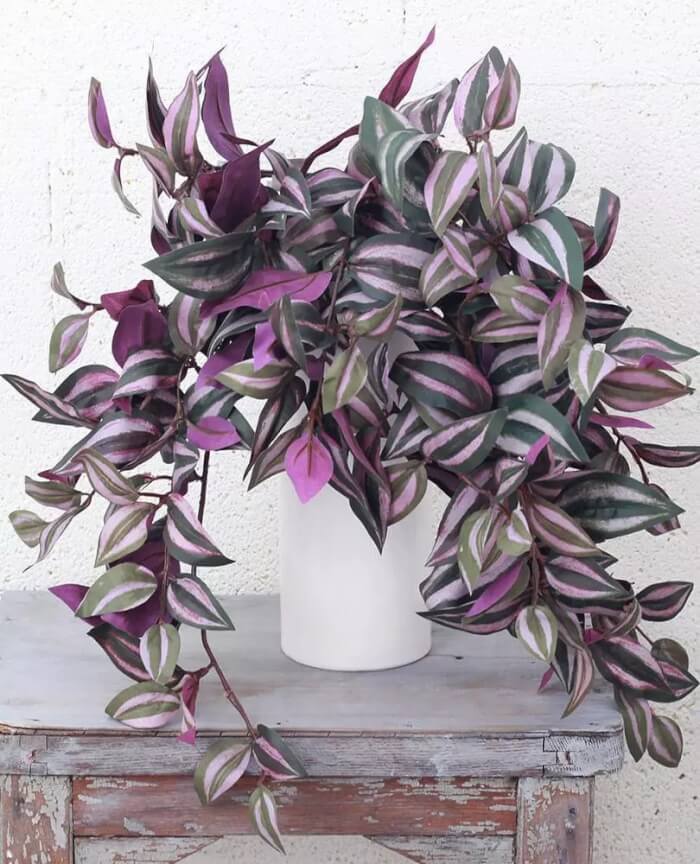
This plant can adapt to a wide range of humidity levels, but it appreciates moderate to high humidity. Keep the soil consistently moist but not soggy.
Water when the top of the soil feels dry to the touch. Ensure that the pot has proper drainage to prevent waterlogged roots, which can lead to root rot.
Also, if you want to expand your collection, this plant is easy to propagate. You can take stem cuttings, typically 4-6 inches (10-15 cm) long, and place them in a jar of water or directly in a well-draining potting mix. Roots will develop within a few weeks.
